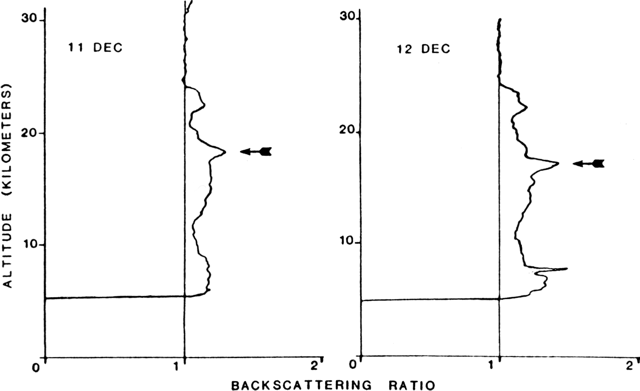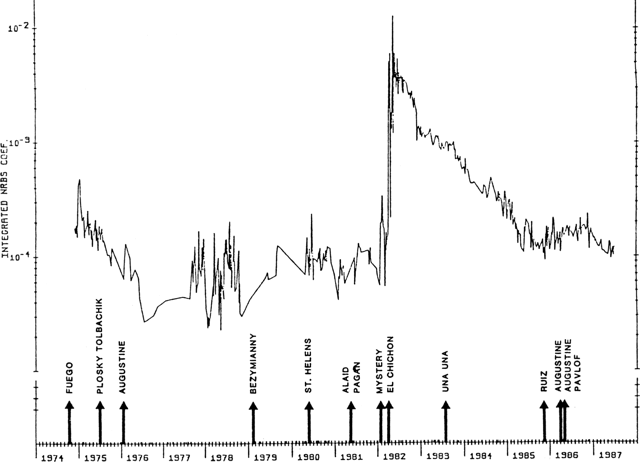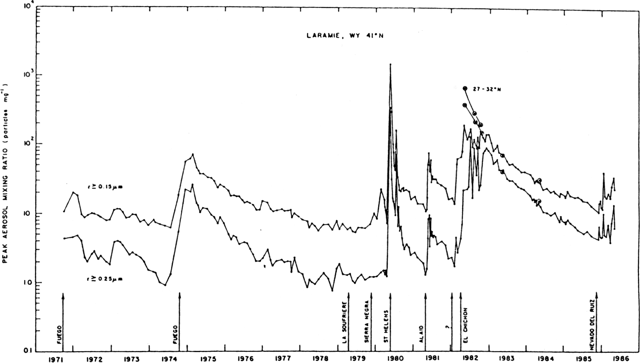Report on Atmospheric Effects (1980-1989) — December 1985

Atmospheric Effects (1980-1989)
Scientific Event Alert Network Bulletin, vol. 10, no. 12 (December 1985)
Managing Editor: Lindsay McClelland.
Atmospheric Effects (1980-1989) New aerosols over Hawaii, Japan, and Wyoming; unusual haze over Fiji
Please cite this report as:
Global Volcanism Program, 1985. Report on Atmospheric Effects (1980-1989) (McClelland, L., ed.). Scientific Event Alert Network Bulletin, 10:12. Smithsonian Institution.
Atmospheric Effects (1980-1989)
All times are local (unless otherwise noted)
Lidar instruments in Hawaii and Japan detected new stratospheric aerosol layers that may have been produced by the 13 November eruption of Ruiz volcano, Colombia. Lidar profiles at Mauna Loa, Hawaii showed a distinct new layer centered at 25-25.5 km altitude on 26 and 27 November. That layer was not detected during the next measurement on 3 December, but distinct new upper tropospheric and lower stratospheric material was evident that night, and apparent new layers centered at 18-22 km were present during the rest of December (figures 13 and 15). At Fukuoka, Japan, a relatively strong scattering layer appeared at 16.9 km (0.2 km above the tropopause observed at the Fukuoka Meteorological Observatory, 7 km from the lidar site) on 28 November, but there were two probable cirrus cloud layers at 6-15 km and it was not possible to confirm that the layer was volcanic. The next night, a very thin scattering layer was present at 18.4 km (3 km above the tropopause); the 29 November lidar profile was of a type not observed except after major volcanic eruptions. Layers were observed at about the same altitude during most December lidar measurements at Fukuoka. Lidar at the National Institute for Environmental Studies at Tsukuba, Japan detected an aerosol layer about 1 km thick at 18 km altitude on 11 and 12 December (figure 14). No such layer had been observed through November. The layer became more obscure 13 and 16 December. Another small layer was detected at about 22 km through December, but it was not certain whether it had been present in previous months. Weak layers centered at 25.8 and 24.5 km were detected from Hampton and Wallops Island, Virginia in December.
The following is from Ram Krishna. "An ususual, heavy haze was observed at Nadi, Fiji (17.78°S, 177.48°E) from 20 through 22 November. The haze significantly reduced the very good visibility normally encountered in this area, and, according to reports by pilots, it extended through the boundary layer to the inversion and was evident for many tens of kilometers across Viti Levu to Vanua Levu. Winds were light throughout the period and meteorological analyses could not provide reliable back trajectories. The appearance, density, and spatial extent of the haze suggest that it was an aerosol formed from volcanic sulfur-containing gas emission not too far upstream. Volcanic activity in Vanuatu has been implicated in previous haze episodes and is a likely explanation for the present episode, but this could not be confirmed. A similarly heavy haze was observed on 21 December, but it did not persist beyond that date."
Four balloon-borne aerosol observations were made over Laramie, Wyoming during December, showing enhanced concentrations of condensation nuclei (CN particles with radii between 0.01 and 0.1 µm) above background, probably from the 13 November eruption of Ruiz (table 2 and figure 15). The strongest enhancement was a 10-fold increase at 15-18 km on 5 December, when smaller increases were also measured at 23 and 28 km altitudes (data in table 2 replace the preliminary 5 December values in 10:11). Only one weak layer was detected on 11 December, but flights on 18 and 31 December showed several zones of enhanced aerosol concentrations. Increased concentrations of optically active aerosols (larger than 0.15 µm) were not present in any of the samplings. Preliminary data from the 10 January flight showed no substantial CN enhancement.
Table 2. Zones of enhanced condensation nuclei concentration detected by balloon-borne instruments over Laramie, Wyoming, 5-31 December. Concentrations are expressed as counts per cm3; normal background concentrations for each altitude are given after the slash. Data courtesy of David Hofmann.
| Date | Altitude (km) | Concentration (/cm3) |
| 05 Dec 1985 | 15-18 | 600/50 |
| 05 Dec 1985 | 23 | 30/7 |
| 05 Dec 1985 | 28 | 10/194 |
| 11 Dec 1985 | 20 | 18/7 |
| 18 Dec 1985 | 12-14 | 70/20 |
| 18 Dec 1985 | 16 | 35/15 |
| 18 Dec 1985 | 18 | 45/8 |
| 31 Dec 1985 | 13-17 | 80/30 |
| 31 Dec 1985 | 19 | 40/10 |
| 31 Dec 1985 | 20 | 15/7 |
| 31 Dec 1985 | 22-25 | 30/7 |
Information Contacts: T. DeFoor, MLO; M. Fujiwara, Kyushu Univ., Japan; S. Hayashida, National Inst. for Environmental Studies, Japan; W. Fuller and M. Osborn, NASA; R. Krishna, Fiji Meteorological Service; D. Hofmann, Univ. of Wyoming.



